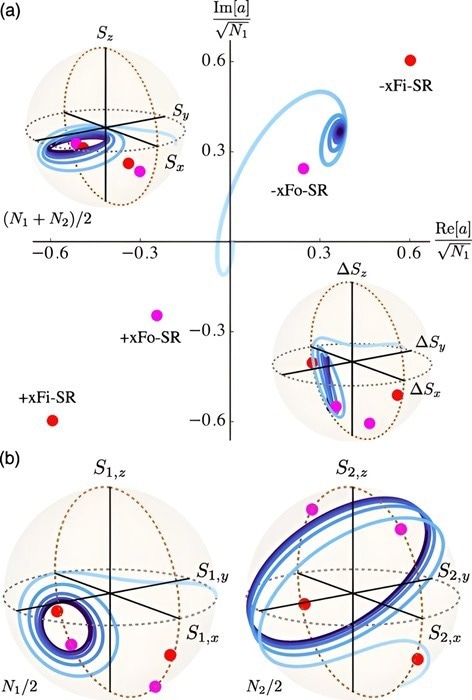Feb 20 2024
The interaction between two sets of light-emitting atoms inside a quantum cavity—an optical device made up of two excellent, small mirrors facing each other that trap light within a small area for a lengthy period of time—has been studied by Theoretical Physicist Farokh Mivehvar.
 The nonequilibrium dynamics of the system. Image Credit: Physical Review Letters
The nonequilibrium dynamics of the system. Image Credit: Physical Review Letters
The model and its predictions may be used in the next generation of superradiant lasers. They can be used and observed in cutting-edge cavity/waveguide quantum electrodynamics research.
One of the most stunning and unexpected phenomena in quantum optics is superradiance. It can be understood by imaging an atom as a tiny antenna emitting electromagnetic radiation or light under suitable conditions.
Now, imagine that there is a collection of N atoms. When these N atoms are located far from one another and thermally excited, they radiate independently from each other so that the intensity of the emitted light is proportional to the number of the atoms, N.
Farokh Mivehvar, Theoretical Physicist, Department of Theoretical Physics, University of Innsbruck
On the other hand, if these atoms are positioned very close to one another, the atomic antennae begin to communicate with one another and synchronize as a result. This results in light emission, the intensity of which increases with the square of the atom count.
One can envisage this situation as the atoms forming a single giant antenna, which emits light more efficiently, and as a result, the atoms emit their energy N times faster than independent atoms.
Farokh Mivehvar, Theoretical Physicist, Department of Theoretical Physics, University of Innsbruck
It is this effect which is referred to as superradiance.
On the Way to Superradiant Lasers
Recently, Farokh Mivehvar has investigated two collections of atoms, N1 and N2, each having a number of atoms inside a quantum cavity in theory. This research was published in the journal Physical Review Letters. The atoms in each ensemble are positioned extremely near to one another and can create superradiant light.
However, it is not obvious a priori how these two giant antennae associated with the two atomic ensembles can emit light simultaneously and this turns out to be nontrivial and in particular, we find two distinct ways that the two giant antennae can emit light.
Farokh Mivehvar, Theoretical Physicist, Department of Theoretical Physics, University of Innsbruck
First, the two enormous antennae create a single super-giant antenna that emits even more light superradiantly. On the other hand, in the second method, the superradiant light emission is suppressed due to the two enormous antennae's destructive competition with one another.
In particular, the superradiant light emission is inhibited when the number of atoms in the two ensembles is equal.
Farokh Mivehvar said, “In addition, we also find cases where the two giant antennae emit light, which is a superposition of the two types mentioned before and has an oscillatory character.”
In cutting-edge cavity/waveguide quantum electrodynamics experiments, the model and its predictions can be implemented and observed. The latest generation of so-called superradiant lasers may also find use in the discoveries.
Journal Reference:
Mivehvar, F. et al. (2024) Conventional and Unconventional Dicke Models: Multistabilities and Nonequilibrium Dynamics. Physical Review Letters. doi.org/10.1103/physrevlett.132.073602.